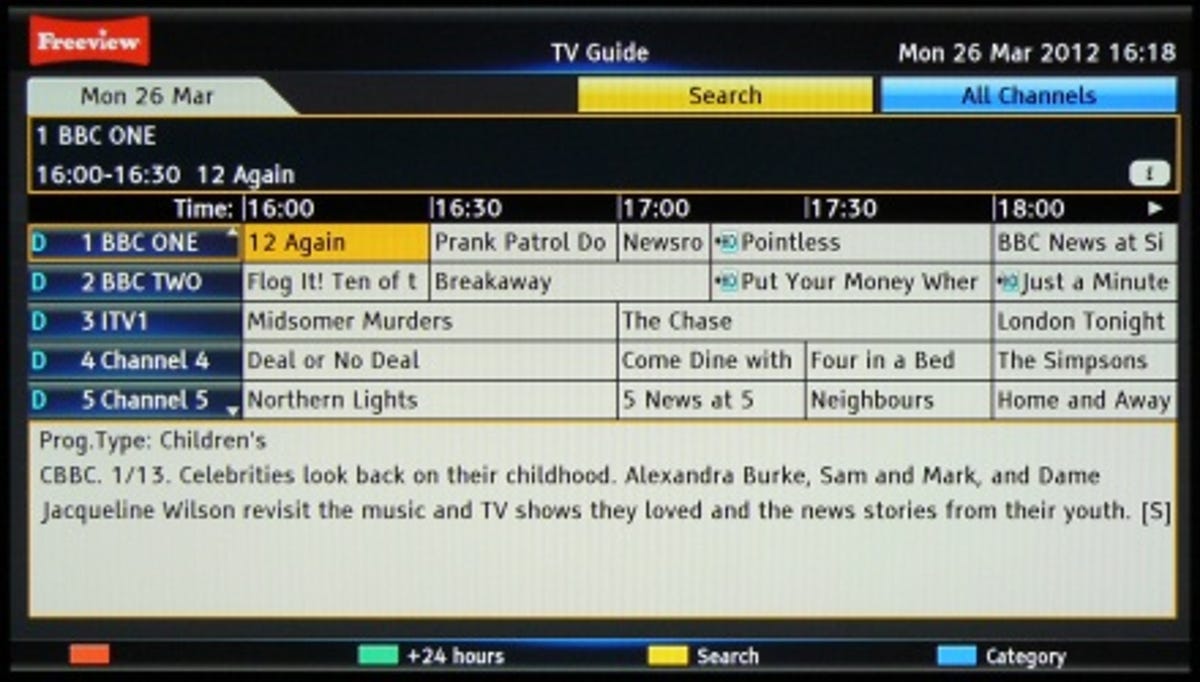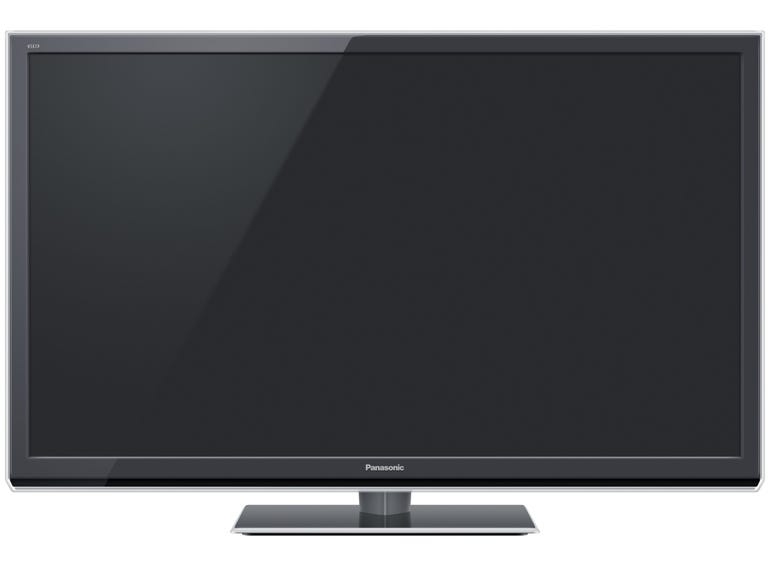 Why You Can Trust CNET
Why You Can Trust CNET Panasonic TX-P42ST50B review: Panasonic TX-P42ST50B
The Panasonic TX-P42ST50B offers truly excellent pictures for standard-definition, HD and 3D, with stunning blacks, brightness and colour.
Panasonic's plasmas have earned an enviable reputation for picture quality, and its latest models claim to improve things even further, upping the brightness while simultaneously improving black levels.
The Good
The Bad
The Bottom Line
The Viera TX-P42ST50B is my first chance to check out whether this is true. Priced at around £950 online, this TV sits below the VT50 and GT50 models in Panasonic's line-up of 3D plasma sets, and above the entry-level UT50.
User interface and EPG
The menu system that Panasonic uses on its TVs badly needs to be updated to bring it into line with more modern offerings from the likes of Sony, LG and Samsung. The bad news is that Panasonic has told me this isn't going to happen until its next generation of TVs.
There are some updates on last year's models but they're mere tweaks. The menus remain dull and dated. Most simply consist of white or yellow text against a blue background, with minimal use of graphics.
At least the electronic programme guide (EPG) has finally been overhauled to remove the web-style adverts that used to clog up the screen. If you pop into the set-up menu, you can now also choose between three layouts for the EPG.
The 'Normal' mode shows seven channels' worth of data at a time, the 'Full' option displays 10, while 'Info' has five channels, but adds a programme description box at the bottom of the screen. While this is welcome, it's still annoying that you lose all sound and video when you use the EPG, as there's no video thumbnail window.

Digital media and Internet features
The TX-P42ST50B is a smart TV so it comes loaded with Panasonic's Viera Connect Internet service. The set is powered by a single-core processor rather than the dual-core chips found in the higher-end VT50 and GT50 models. As a result, it doesn't feel quite as quick as those models when you're navigating around the Viera Connect menus.
It does benefit from the updates that Panasonic has made to the Viera Connect system though. There's more content, including a welcome Netflix app, although sadly Lovefilm is still not supported. The YouTube app has been updated with the 'lean-back' interface that's designed for use on a telly.
Along with the full Facebook and Twitter apps is Social TV, which shows tweets and status updates in a window while you're watching TV. You can even now download a full web browser for free from the Connect store, although sadly it doesn't support Adobe Flash and still seems a tad buggy as it crashed a number of times on me. Naturally, the old stalwarts remain, such as BBC iPlayer, Dailymotion, AceTrax and Aupeo.
The Connect interface remains unchanged from last year. It's relatively easy to use, but the 3D-layers approach used on the design of the home screen makes moving around pages of apps sluggish. The system lacks some of the visual flair you get on Samsung and LG's smart TVs and the range of apps is also less impressive. It's still better than what you'll find on sets from Toshiba and Philips though.
This model has a built-in media player that can playback files across a network or locally, either from SD cards or USB drives. Playback quality is excellent and the range of formats supported is good. I had no problem playing a number of Xvid and MKV HD video files, for example. The TV even supports downmixing of DTS soundtracks to stereo.
As with last year's ST30, you can record Freeview programmes directly to USB drives. However, drives have to be formatted first before they can work with the set and recordings are locked to the TV -- they can't be played back on other devices, which is annoying.
Design and connections
Last year's Panasonic plasma models may have offered very good picture quality, but their dull designs left a lot to be desired. Thankfully, this year's models are much better lookers. Panasonic has taken a leaf out of the LG design handbook as the styling bears a striking resemblance to last year's LG sets.
The main similarity is the transparent lip around the outer edge of the bezel -- something that's been a trademark of LG's designs for a while. This 'crystal' edging, along with the narrowness of the bezel and general slimness of the chassis, makes for a relatively handsome-looking telly.
The remote has received a makeover. It now has a glossy coating on the front and a more aggressive, angular look. The buttons are no longer hard black plastic, but are instead made from soft white rubber that allows the new red backlight to shine through.
Panasonic has rejigged the location of the connectors, compared to last year's ST30. All three of the HDMI ports are mounted on a panel on the left-hand side, whereas two of these used to be found on the rear. The full-sized Scart socket and component inputs have been removed, probably because the chassis is slimmer. You have to connect up Scart and component devices using small break-out cables. There is an optical output to feed audio from the onboard Freeview HD tuner to a surround sound amp.
Unlike the higher-end models, this set doesn't have a Freesat tuner -- although that's not exactly a must-have anyway. On the networking front, there's an Ethernet port, but Wi-Fi is finally built in, so you no longer have to shell out for an expensive add-on. The left-hand panel is also home to two USB ports and an SD card slot.
2D picture quality
One of the most impressive things about this display is that Panasonic has simultaneously increased the depth of its black levels while upping the panel's brightness. The black levels really are something special. They're noticeably deeper than on last year's models, which in themselves were no slouches in this department. Black levels are important as they help the screen to produce a richer, more cinematic picture.
The improved brightness levels are welcome too. While I don't think they've increased by the 30 per cent that Panasonic quotes in its marketing material (and they're still some way off what you'd get from today's LED sets), the increase in light output does help to give pictures a tad more 'pop'. Colours look that much more vivid too.
Traditionally, plasmas have been better at dealing with motion than LCD and LED screens as the technology is inherently less prone to motion blur. Panasonic has managed to improve the motion performance of this panel even further. Motion is supremely cleanly handled, even when you've got the Intelligent Frame Creation (IFC) processing turned off. In fact, it's best to use the IFC setting sparingly. For most material you'll want it turned off or set to its minimum setting. Otherwise it can flatten out the depth cues in films, making them look more video-like.
Panasonic's plasmas have always done a good job of upscaling standard-definition feeds and thankfully that hasn't changed here. Even the ropier channels on Freeview are handled sympathetically, so they look as sharp as possible. Some of the weaknesses in the signal are masked rather than amplified, as some TVs tend to do.
HD pictures are even more awe-inducing. The combination of the set's higher brightness levels, deeper blacks and rich colour tones makes watching movies on Blu-ray a joy. What's more, Panasonic's picture presets are actually very good, with the True Cinema one in particular delivering very accurate results right out of the box.
3D picture quality
Unfortunately, this set doesn't come with any 3D glasses. Instead, you'll have to shell out around £50 per pair if bought online. This TV uses different glasses to last year's models. The new TY-ER3D4ME specs are smaller and much lighter. Weighing in at 23g, they're a lot more comfortable to wear. They also use Bluetooth rather than infrared for syncing with the set, so they no longer need a line of sight to stay in sync.
As with all active-shutter glasses, however, you can see flickering on any ambient light in your room, which can be distracting. There are now settings on the TV that you can use to adjust the timing of the shutters in the glasses to reduce this flicker, but these can introduce ghosting if you don't use them in conjunction with the IFC processing.
Nevertheless, this set's 3D performance is first-rate. The TV's extra brightness levels help to combat some of the dimming effect of the glasses. So although 3D images are still not as bright as you'd get from an LED TV, they do have more punch than those on last year's ST30 and the results are much more enjoyable.
There's pretty much no crosstalk -- or image ghosting -- visible in 3D images either, so pictures look not only very crisp, but also solid, helping to reinforce the impressive sense of depth. In short, this is an excellent set if 3D is your bag.
Audio quality
I complained about the audio on Panasonic's smaller TX-L32ET5B -- the poor quality of its sound was unusual as Panasonic tends to make more of an effort than most with the built-in sound on its tellies.
Thankfully, the TX-P42ST50B's audio is much stronger. The mid-range is a lot cleaner so dialogue is very crisp, and high-frequency sounds aren't as screechy. However, I didn't think the audio was quite as full or as bass-heavy as the ST30. I suspect this is partly due to the slimmer chassis compromising the amount of space dedicated to the speaker system.
Conclusion
There's little to fault with the TX-P42ST50B's picture quality. Its black levels are among the best I've seen on plasma TVs -- certainly comparable to last year's very pricey VT30 -- yet it also produces brighter images and punchier colours.
HD movies look superbly crisp and detailed and even standard-definition material is deftly handled. The EPG and menu system lag behind the competition, but overall, this is an excellent plasma.
If you're in the market for a new TV, you might want to wait to see what Panasonic's GT50 has to offer before opting for this model. I'll bring you the GT50 review as soon as I can.


